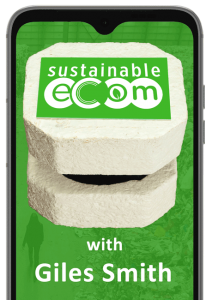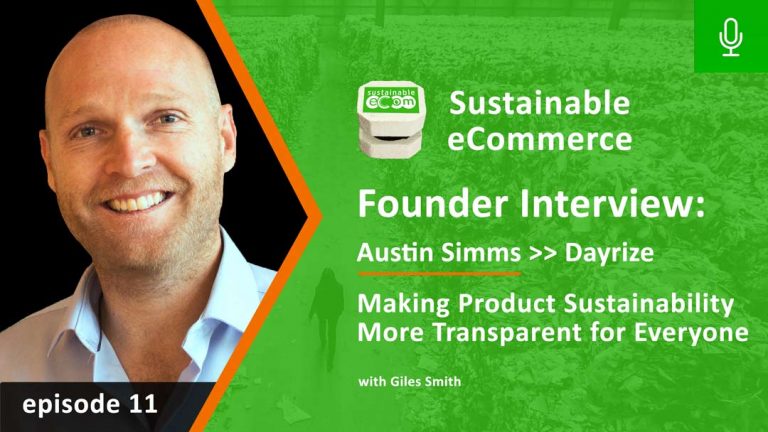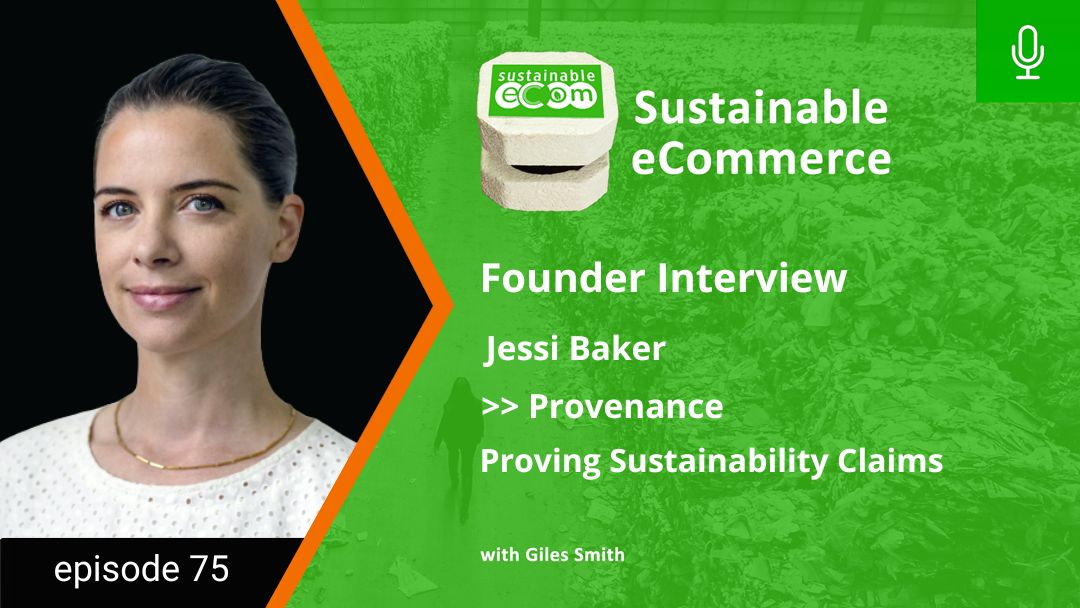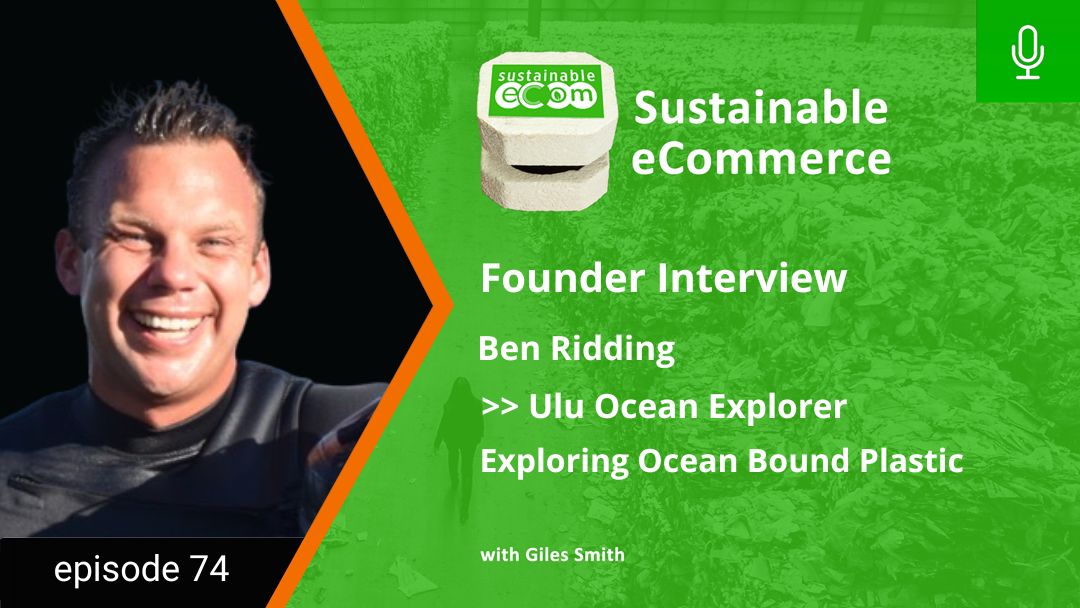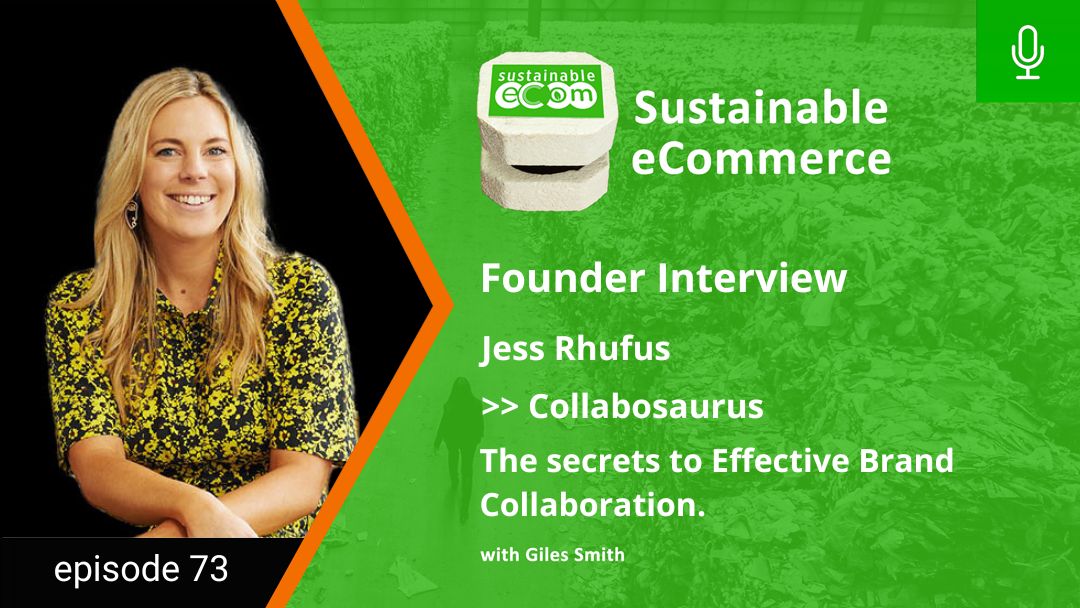Welcome to Episode 11 of the Sustainable eCommerce Podcast!
Today I’m joined by another amazing Aussie entrepreneur. Austin Simms is the founder of Dayrize, a software platform revolutionizing product impact assessments for all brands.
The platform makes it easier to improve products, easier to benchmark their all round sustainability, helps customers make better buying decisions.
Best of all, when compared with the classic lifecycle assessment, it is much faster, requires less information input and best of all much, much more cost effective!
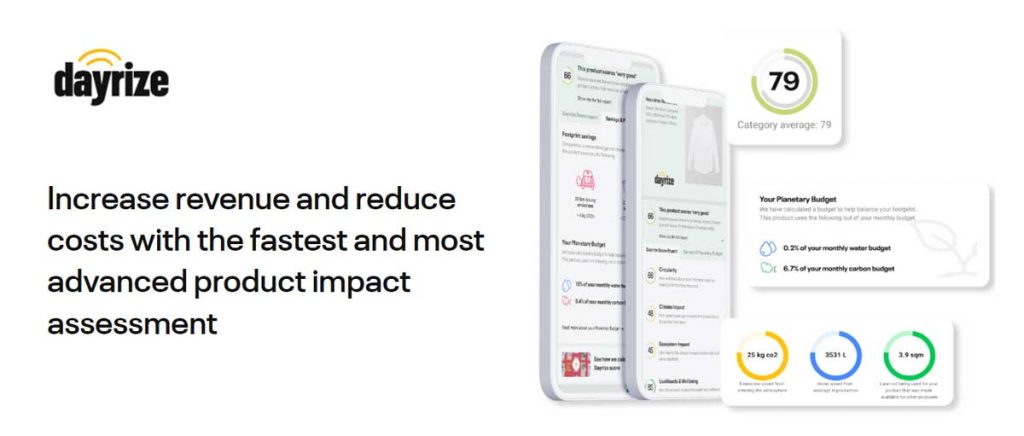
Giles Smith: Austin, welcome to the show! Your system is exciting because it solves probably one of the most intractable problems for sustainable brands which is the ability to measure, report on, take action on and then communicate the sustainability of a brand’s products. But before we get into that, tell us a little bit about you and how you ended up building this amazing tech company in Amsterdam!
Austin Simms: Thanks for that set up. So I've been in Amsterdam for 15 years now, although hopefully you can see that my accent hasn't got any softer. I worked here at Nike for a long time. I left Nike a while ago and worked at a few big Dutch brands, including Tomtom and Phillips. But, we still call Australia home as they say.
Dayrize Product Impact Assessments
Giles Smith: Awesome. So, let's get stuck in. Clearly one of the biggest challenges for brands of all sizes is being able to measure the sustainability of their products, and being able to communicate that in a way to their customers. They need to do that in a way that is understandable and consumable by consumers so that they can make good choices about the products they're buying, as well as avoiding greenwashing. Tell us about how you help brands so that at Dayrize.
Austin Simms: We started Dayrize back in 2019. We set out on a mission to bring transparency to consumers. We thought it was crazy that when people go shopping there's no way of understanding the impact of the products they purchase. That leads us in a really difficult position as consumers to make more informed decisions. So we wanted to figure out how to bring a level of transparency to products, similar to food packaging.
We work with big multinational brands and smaller SMEs, and the problem is the same. It's really nuanced and difficult to understand the impact at a product level. What we realized was to reach our ultimate ambition of bringing a level of transparency to consumers, the first thing we had to do was bring a level of transparency to the brands as well.
So we got 20 of the world's top environmental scientists together and worked on this for two and a half years and came up with a product that can bring that level of transparency.
The magic works in a couple of ways. We work directly with the brands to extract a level of information about their products. Of the over 500 brands we’ve worked with so far, none have all the data points we really need in order to give an accurate, robust measurement of a product’s sustainability.
So, the first way our technology works is it actually can fill in missing information. Our smart algorithms and machine learning that can pull on different data sources that do give a really accurate approximation of any information gaps that you have.
For example, we know if you're producing cotton in Sri Lanka that already gives us a really good steer on certain impact levels. We've got 31 different databases that we call upon to fill any information gaps. That's the first thing that's really important. Without that, brands only option is to do a full lifecycle assessment, which takes months, and can cost about $30,000 per product. So essentially what we're doing with our technology is accelerating that process by using the technology to approximate the missing information. That means we can complete the assessment in minutes rather than months!
The 5 Dimensions of Sustainability
The second way the technology works is we are not only the fastest, but we're the most holistic in terms of the measurements that we give you as a brand. We take that information and assess it across five dimensions of sustainability.
The first one is carbon impact, or the climate impact as we call it. And that's the one that we all know. That's the greenhouse gases that contribute to the products all the way from sourcing and extraction to manufacturing & distribution. We measure that and we break that down across those three areas.
We then measure the ecosystem impact. That’s primarily to do with sourcing, but also through the rest of the supply chain. What's your impact on the habitat & bio-diversity when you're primarily sourcing virgin materials? What's your water usage, and what impact does that have?
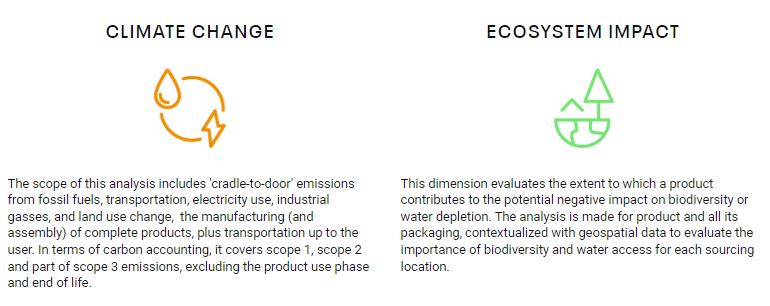
The third one is the circularity of a product. When you're making product, how much of the material that you're using can be re-used or recycled? How much pressure are you putting on virgin materials versus using materials that have been re-used. Just as importantly, what happens to your product at end of life. Can it be reused or recycled? So, we were trying to create these loops of recyclability or circularity, and we assess your product in terms of that.
The fourth one is livelihoods and wellbeing, so we don't just look at the environmental impact, we look at the social impact as well. We look through your supply chain and look at the risk associated with child slave labour, how are people treated through your supply chains? We want to make sure that what your making is sustainable in the broader sense of the word, not just environmentally sustainable, but sustainable for the communities that are touching that product as well.
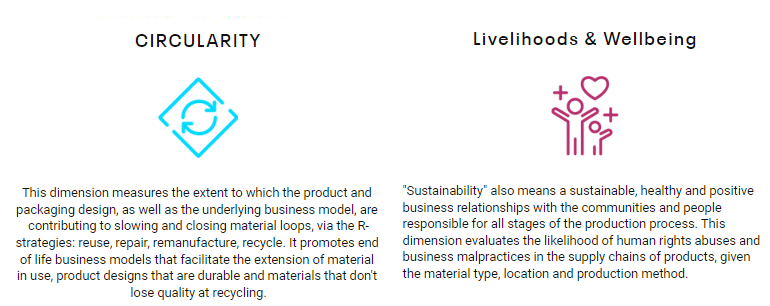
And the last thing we look at is purpose, which is the hardest one for us to quantify, but we do it based on Maslow’s hierarchy of needs. The world is finite in its resources, and we need to make sure that we're funnelling those resources to the areas that have the greatest value. Not every product is equal in terms of its use, so we grade products according to their usefulness of purpose.
What’s really interesting is the output you get from that assessment. We are all about providing solutions to consumers and businesses to help everyone make better decisions and help everyone on a path of making better products and reducing the impact on the planet.
So there’s two outputs. One is, brands get really detailed reports across those five dimensions. You know how your compare to other products and your peer category? Then, we actually give you suggestions on how you can improve, how you can actually reduce the impact of the product. We find that is really insightful, particularly for small and medium sized brands.
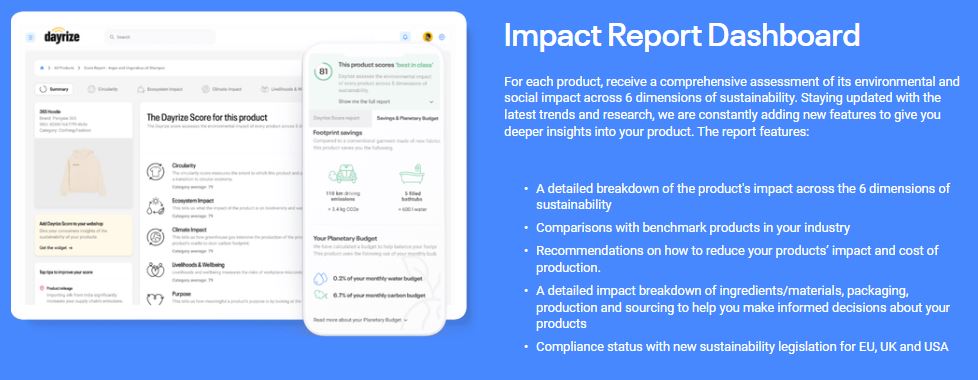
And the second thing that you get is really simple tools that actually enable you to tell this story to consumers. This is all housed in a dashboard and you can extract this information and put it onto your own e-commerce channels or your partner's e-commerce channels. It's a Dayrize score. We rate every product out of a hundred, and it’s a rating that’s made up of those five dimensions that I spoke about. That means that consumers can get a really good sense of how sustainable it is, but circularity might be more important to some people then love people moving, for example. We also compare your product to a ‘standard’ product, which allows brands to communicate how sustainable their product is compared to a standard product. You’re about to communicate that by purchasing your product, the consumer is saving this much carbon or this much water.
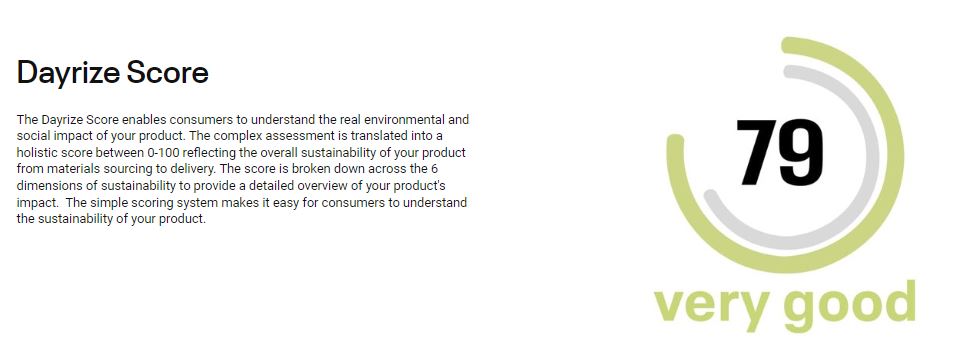
Then the final piece which we’re excited about is, we each have a planetary budget that we can consume within each year. When we consume more than that, its’ called earth overshoot day, which happens earlier and earlier each year.
We can actually assess each product and tell you how much of your planetary budget that takes up. That's going to be a real game changer because that gives consumers the level of transparency they need to make better decisions.
Giles Smith: Okay. Wow! What you've just laid out there is kind of like a product sustainability panacea. It covers off all of the things that we need to look at as brands when it comes to product sustainability. So brands can now get a clear view of their carbon impact, but also a much more rounded view of sustainability so that they can make improvements.
Austin Simms: Yeah, I think the great thing about the tool is brands can get clarity on exactly where their impact is. Is it a material level? Is it your packaging? By giving that granularity, you can focus on areas where you think you can make the biggest impact.
How Do Dayrize Product Impact Assessments Work for eCommerce Brands?
Giles Smith: With regards e-commerce in particular, there are many different business models. I think it’s clear how brand manufacturers can leverage your system. A few weeks ago, we chatting with Lottie from Banish on the show, which is a sustainable marketplace. How can retailers like that work with you?
Austin Simms: We work with a lot of retailers, and I guess there's a couple of different ways they approach it. Some mandate their brand suppliers go through this assessment and actually have their products assessed to be listed on the marketplace.
The other approach for retailers is to offer it as part of the service on their platform. In that way you’re providing a service to the brands but also the kind of transparency that we know consumers are looking for.
In addition, with the big retailers, we actually seeing they're using it as a buying tool. So, they might be given a range of sustainability they can purchase products within as a kind of KPIs along with price. In effect, an impact zone. They can’t buy products that don’t fall within a given impact zone.
Giles Smith: How about private labellers. In many cases they don’t have access to the complete supply chain, how can they leverage your platform to make good sourcing decisions. How can they get involved?
Austin Simms: The reality is we do need a certain level of information to complete the assessment, but we can also work with white label brands. Our tool is fully automated, but we do provide a highly consultative service to help people go through that process and extract information. In some cases, we can actually contact the factories on the half of brands to get the information. We know the right questions to ask them what format it's generally in.
How Cost Effective is the Dayrize System?
Giles Smith: You mentioned at the outset that lifecycle assessments take months, require enormous piles of information and cost tens of thousands of dollars to complete. That puts it completely out of the question for searching for third party products, and it also makes it a lot more expensive to bring new sustainable products in as a brand manufacturer. Tell us how much it costs on the Dayrize platform to do one of these assessments.
Austin Simms: We’ve worked really hard to make sure that this is accessible to everyone. At our core we're about democratizing sustainability. So our assessment is about 60 Euros, which I think is about $90 per product. That makes it affordable for small brands as well as big corporations with thousands of products.
Giles Smith: That is incredibly cost-effective! What it means is that there's simply no roadblock to any brands getting involved and understanding the real sustainability position of their product. That’s $90 per product per year, right?
Austin Simms: Good point, it's good to clarify that. It's an annual subscription charge. The reason for that is we actually update the methodology each year. Science doesn't stand still. We've got the most up-to-date and accurate scoring system. We actually have a really rigorous peer review where we send out our methodology to leading academics and NGOs to get them to critique it. We update the scores once a year, so it's important that it's an annual subscription.
How Can You Get a Product Impact Assesment?
Giles Smith: That makes complete sense. Let's get a little bit practical. What's the step-by-step process. What does that look like? How do I engage with you?
Austin Simms: The good thing is we've got a really smart wizard online that just walks you through the process. So depending on what product category you're in and the answers that you give, the tool constantly updates to ask you the right questions. It's very simple to follow, very easy. We find that the first product takes about 20 minutes to fill out, because you just need to get used to the tool. You get your own dashboard that you go into. For similar products you can clone your answers so you can get through multiple similar products very quickly.
Giles Smith: One of the big issues all brands face is in communicating what they're doing. Transparency is very important. Nobody wants to be accidentally greenwashing, but in order to educate the consumer properly, we need to be able to communicate what we're doing.
Building brand story is probably the linchpin that makes all sustainable brands grow. And it's going to become more important, not less important as we move forward with this agenda. So, what's your advice on how people can best leverage the outputs of this into their overall brand story? What are some of the really smart ways you've seen brands do this?
Austin Simms: I love that question. That's, it's so important for us. We need to be telling the story and proudly telling the story about sustainability. Consumers want this, we know they do. They want this level of transparency.
There are emerging brands out there that are making amazing sustainable products. They're disrupting the market and they need to be celebrated. So I really encourage the brands to get into the storytelling and be proud about it and focused on the positives of it. Lean into the story, tell your brand story, be proud of the sustainability and focus it in a positive sense.
Obviously now with the Dayrize tools, there's external validation. Hopefully we have a small part to play in the bigger story.

Giles Smith: I think you smashed it there! We've finished on the reason that I knew I had to talk with you today, because I've been looking for ways to provide the validation that people need to be honestly telling a story. I think Dayrize is the missing piece of the puzzle.
Where can brands get involved with you?
Austin Simms: Our website is dayrize.io or you can email me at austin@diarize.com and we'd love to hear from you.
Key Takeouts from Today’s Show:
As humans we have a tendency to focus on the things making the most noise. That’s obviously things like the plastics problem and global warming, and while those issue are massive and absolutely critical to address, we can’t focus on those at the exclusion of other parts of our ecosystem.
Secondly, the Dayrize system levels the playing field in sustainability assessment for brands. At just $90 per product per year, that may be the same as the gross margin on a single sale! For the first time, product sustainability assessments are available to everyone.
Lastly, Austin made the point that customers want transparency, and want to understand the story behind your brand. When you weave your mission into a story that makes sense to the customer, and back it up with the transparency of Dayrize certification, you’ve got a very powerful way to stand out from the crowd!





